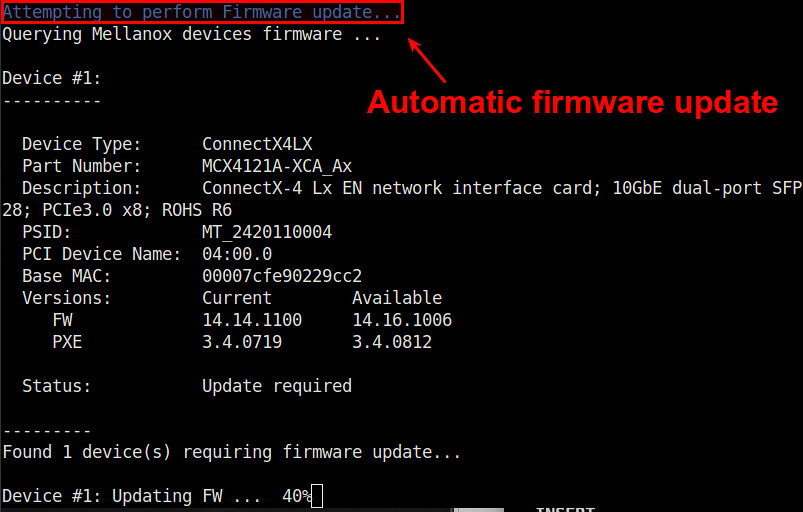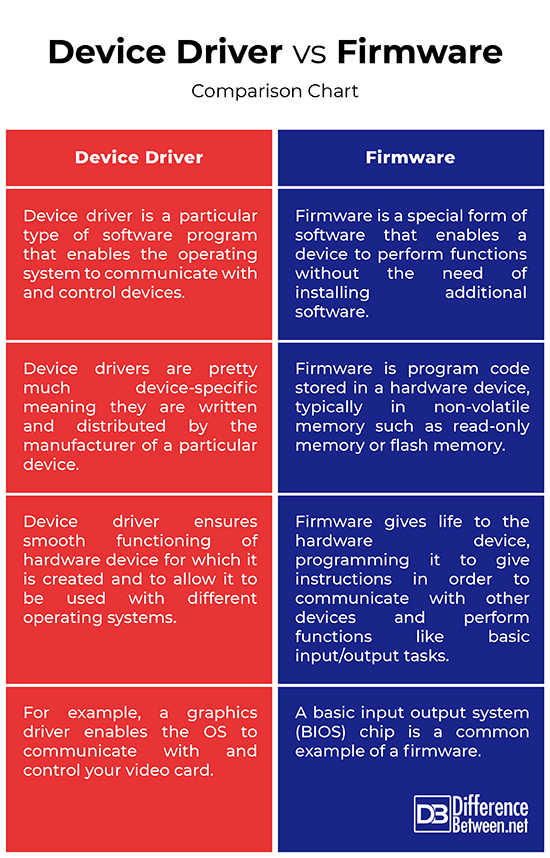Difference Between Device Driver and Firmware
A typical computer consists of hardware, software and firmware. These components work together to make the computer work in a way it’s designed to work. Hardware is any physical device that you can actually see and touch, whether internal to the computer or external devices attached to the computer. We use numerous hardware devices with a computer, such as printer, scanner, mice, keyboard, monitor, disk drive, audio card, video card, and modem are all examples of hardware devices. Software is a set of instructions that tell the computer how to work and execute specific tasks. Unlike hardware which describes the physical aspects of a computer, software is anything that can be stored electronically and it’s an immaterial part that runs a computer. Device drivers are also software. Firmware is also software, but programmed on a hardware device.

What is a Device Driver?
Device driver is a particular type of software program that enable hardware devices to interact with each other. It is a software application that acts as an intermediary between a piece of hardware and an application or the operating system. A computer operates a great many kinds of devices, most of which fit into the general category of storage devices, transmission devices, and human-interface devices. A device communicates with a computer system through its associated device driver. So, a device driver communicates with the hardware device via a connection point, or port – for example, a serial port. Device drivers are specific to operating system which allow the kernel of the OS to communicate with hardware devices, without worrying about the details of how they actually work. A device driver presents a uniform device-access interface to the I/O subsystem, much like the system calls which provide a standard interface between the application program and the operating system.

What is a Firmware?
Firmware is a set of instructions programmed into a hardware device, typically in non-volatile memory such as read-only memory or flash memory. Firmware is a special form of software that enables a device to perform functions without the need of installing additional software. It refers to computer programs and data loaded into a class of memory that cannot be dynamically modified by the computer during processing. Firmware includes the internal set of instructions used by a hardware device for initiation and operation, often encoded in non-volatile memory. A basic input output system (BIOS) chip is a common example of a firmware. The computer programs and data contained in firmware are classified as software. Firmware is typically stored in the read-only memory of a hardware device, and can be erased and rewritten. Firmware updates often require specialized standalone applications, custom boot mechanisms, and require extensive research as each vendor provides one or more versions of firmware updates for its device.
Difference between Device Driver and Firmware
Basics
– Device driver is a particular type of software program that enables the operating system to communicate with and control devices. Device drivers are pretty much device-specific meaning they are written and distributed by the manufacturer of a particular device. Firmware, on the other hand, is a special form of software that enables a device to perform functions without the need of installing additional software. Firmware is program code stored in a hardware device, typically in non-volatile memory such as read-only memory or flash memory.
Functionality
– Device drivers are operating system-specific and hardware dependent that enable operating system and other software programs to access hardware functions without worrying about the details on how the hardware devices work. Without a device driver, the OS won’t be able to communicate with a hardware device. Firmware, on the other hand, is software permanently etched into a hardware device that enables the device to perform functions like basic input/output tasks, without the need of installing additional software. It carries out the integral functions of hardware devices.
Purpose
– The purpose of a device driver is to ensure smooth functioning of hardware device for which it is intended to work and to also allow it to be used with different operating systems. For example, a graphics driver enables the OS to communicate with and control your graphics card or video card or on-board graphics. Firmware, on the other hand, is a software program that gives life to the hardware device, programming it to give instructions in order to communicate with other devices and perform functions like basic input/output tasks.
Device Driver vs. Firmware: Comparison Chart

Summary of Device Driver vs. Firmware
The main difference between a device driver and a firmware is their intended purpose. Device drivers enable operating system and other software programs to access hardware functions without worrying about the details on how the hardware devices actually work. Firmware is also software, in the context that it is program code. The difference lies in how the program code is stored. Firmware includes the internal set of instructions used by a hardware device for initiation and operation, often encoded in non-volatile memory.
- Difference Between Caucus and Primary - June 18, 2024
- Difference Between PPO and POS - May 30, 2024
- Difference Between RFID and NFC - May 28, 2024
Search DifferenceBetween.net :
1 Comment
Leave a Response
References :
[0]Image credit: https://live.staticflickr.com/7427/27888997272_ae1232e503_b.jpg
[1]Image credit: https://en.wikipedia.org/wiki/File:Driverarch.png
[2]Tidrow, Rob, et al. Windows 10 Anniversary Update Bible. Hoboken, New Jersey: John Wiley & Sons, 2017. Print
[3]Silberschatz, Abraham, et al. Operating System Principles (7th edition). Hoboken, New Jersey: John Wiley & Sons, 2006. Print
[4]Pecht, Michael. Product Reliability, Maintainability, and Supportability Handbook. Boca Raton, Florida: CRC Press, 2009. Print
[5]Hausman, Kirk. Sustainable Enterprise Architecture. Boca Raton, Florida: CRC Press, 2011. Print

So who handles internal functioning of hardware devices?